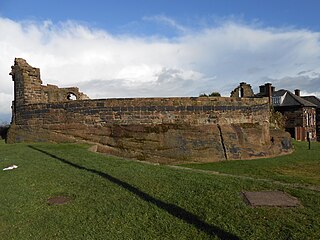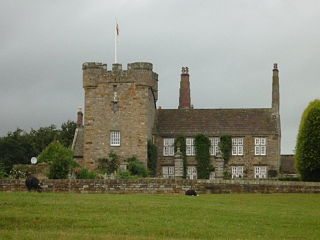
Runcorn is an industrial town and cargo port in Halton, Cheshire, in the southeast of the Liverpool City Region. Its population in 2011 was 61,789. The town is on the southern bank of the River Mersey, where the estuary narrows to form the Runcorn Gap. Directly to the north across the River Mersey is the town of Widnes, upstream and 8 miles (12.9 km) to the northeast is the town of Warrington, and downstream and 16 miles (26 km) to the northwest is the city of Liverpool.

Halton is a local government district in the ceremonial county of Cheshire in North West England, with borough status and administered by a unitary authority. It was created in 1974 as a district of the non-metropolitan county of Cheshire, and became a unitary authority area on 1 April 1998 under Halton Borough Council. Since 2014 it has been a member of the Liverpool City Region Combined Authority. The borough consists of the towns of Runcorn and Widnes and the civil parishes of Hale, Daresbury, Moore, Preston Brook, Halebank and Sandymoor. The district borders Merseyside, Warrington and Cheshire West and Chester. The borough straddles the River Mersey – the area to the north is historically part of Lancashire, that to the south part of Cheshire.

The Regional Municipality of Halton, or Halton Region, is a regional municipality in Ontario, Canada, located in the Golden Horseshoe of Southern Ontario. It comprises the city of Burlington and the towns of Oakville, Milton, and Halton Hills. The region provides policing by the Halton Regional Police Service. The regional council's headquarters are located in Oakville. Burlington and Oakville are largely urban and suburban, while the towns of Milton and Halton Hills are more rural.

Weaver Vale is a constituency represented in the House of Commons of the UK Parliament since 2017 by Mike Amesbury, a member of the Labour Party.

Halton-with-Aughton is a civil parish and electoral ward located 3 miles (5 km) east of Lancaster, England, on the north bank of the River Lune. The main settlement is the village of Halton, commonly just called Halton, in the west, and the parish stretches to the hamlet of Aughton in the east. It lies in the City of Lancaster district of Lancashire, and has a population of 2,227, down from 2,360 in 2001.
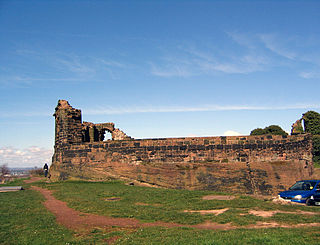
Halton, formerly a separate village, is now part of the town of Runcorn, Cheshire, England. The name Halton has been assumed by the Borough of Halton, which includes Runcorn, Widnes and some outlying parishes.

de Lacy is the surname of an old Norman family which originated from Lassy, Calvados. The family took part in the Norman conquest of England and the later Norman invasion of Ireland. The name is first recorded for Hugh de Lacy (1020–1085). His sons, Walter and Ilbert, left Normandy and travelled to England with William the Conqueror. The awards of land by the Conqueror to the de Lacy sons led to two distinct branches of the family: the northern branch, centred on Blackburnshire and west Yorkshire was held by Ilbert's descendants; the southern branch of Marcher Lords, centred on Herefordshire and Shropshire, was held by Walter's descendants.
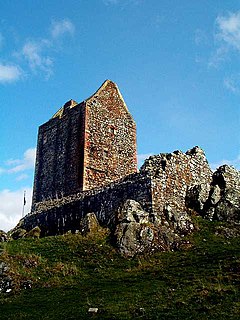
Barmkin, also spelled barmekin or barnekin, is a Scots word which refers to a form of medieval and later defensive enclosure, typically found around smaller castles, tower houses, pele towers, and bastle houses in Scotland, and the north of England. It has been suggested that etymologically the word may be a corruption of the word barbican. The barmkin would have contained ancillary buildings, and could be used to protect cattle during raids.

The Barony of Halton, in Cheshire, England, comprised a succession of 15 barons who held under the overlordship of the County Palatine of Chester ruled by the Earl of Chester. It was not therefore an English feudal barony which was under full royal jurisdiction, which is the usual sense of the term, but a separate class of barony within a palatinate. After the Norman conquest, William the Conqueror created three earldoms to protect his border with Wales, namely Shrewsbury, Hereford and Chester. Hugh Lupus was appointed Earl of Chester and he appointed his cousin, Nigel of Cotentin, as the first Baron of Halton. Halton was a village in Cheshire which is now part of the town of Runcorn. At its centre is a rocky prominence on which was built Halton Castle, the seat of the Barons of Halton; the castle is now a ruin.

Runcorn is an industrial town in Halton, Cheshire, England, on the south bank of the River Mersey where it narrows at Runcorn Gap. In the town are the 61 buildings that are recorded in the National Heritage List for England as designated listed buildings in the current urban area of Runcorn, including the districts of Runcorn, Halton, Weston, Weston Point, and Norton. Two of these are classified as being in Grade I, nine in Grade II*, and fifty in Grade II.
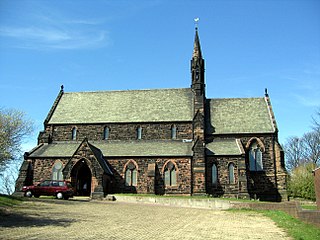
St Mary's Church is in Halton, which was formerly a separate village, but is now part of the town of Runcorn, Cheshire, England. It is an active Anglican parish church in the diocese of Chester, the archdeaconry of Chester and the deanery of Frodsham. The church is recorded in the National Heritage List for England as a designated Grade II listed building.
John Savage, 2nd Earl Rivers was a wealthy English politician and Royalist from Cheshire.
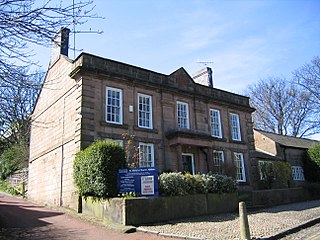
Halton Vicarage is in Castle Road, Halton in the town of Runcorn, Cheshire, England. It is recorded in the National Heritage List for England as a designated Grade II* listed building.
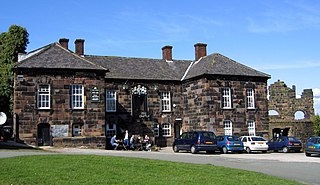
Castle Hotel stands at the top of Halton Hill in Halton, Runcorn, Cheshire, England. Its side walls are continuous with the curtain walls of the ruins of Halton Castle. It is now a public house and is recorded in the National Heritage List for England as a designated Grade II* listed building..
William fitz Nigel, 2nd Baron Halton, was a prominent 12th-century noble. He was a son of Nigel, 1st Baron Halton. William died in 1134.
There are over 9,000 Grade I listed buildings and 20,000 Grade II* listed buildings in England. This page is a list of these buildings in the borough of Halton in Cheshire.
